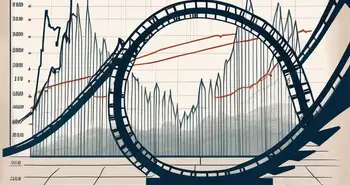Best Undervalued Stocks for Investment

We’ve all been there, trying to figure out where to put our money but feeling a little unsure about which assets are worth it. If you’re looking for a way to make smarter investment choices and find undervalued stocks (ones that are ready to grow), you’re in the right place.
Investing in the stock market doesn’t have to be intimidating. With our “Stock Market Investing” series, you’ll be guided step by step. When you're ready to enter the market, finding undervalued stocks is one of the best ways to make your first investment and set yourself up for success in the long run. But how do you spot these undervalued opportunities?
Let’s break it down step by step, and I’ll show you some real examples of companies that could be the hidden gems you’ve been searching for.
What are Undervalued Stocks?
First, let's start with the basics. Undervalued stocks are simply stocks that are selling for less than what they’re really worth. Sounds too good to be true, right? But here’s the thing: sometimes, for all sorts of reasons, whether it’s market overreaction, company setbacks, or simply being overlooked by other investors, a stock can be priced lower than its actual value.
Think of it like finding a high quality laptop on sale because it’s being overlooked by other shoppers. If you know the brand and understand the value, you can snag it at a great price. That’s what happens when you find undervalued stocks. You spot an opportunity before others realize its true worth.
How Do You Find the Best Undervalued Stocks?
Spotting undervalued stocks isn’t about picking random names and hoping for the best. There are a few key things to look for when you're searching for these potential winners:
Earnings Growth: A company that’s growing and showing strong potential to continue that growth is often undervalued if the stock price hasn’t caught up yet.
Price-to-Earnings (P/E) Ratio: This tells you how much you're paying for each dollar of the company's earnings. If the P/E ratio is lower than the industry average, the stock might be undervalued.
Price-to-Book (P/B) Ratio: This is another useful metric. If the P/B ratio is under 1, the stock might be trading below its true value.
Price-to-Earnings-to-Growth (PEG) Ratio: A PEG ratio under 1 indicates that a stock is undervalued compared to its expected growth, which could make it an excellent buy.
These ratios are like the tools in your financial toolbox. By looking at them, you get a clearer idea of whether the stock is priced lower than what it should be, kind of like finding that perfect deal on something you’ve been eyeing.
Best 5 Undervalued Stocks
Let’s take these concepts and apply them to some real-life examples. I’ve pulled out five companies that meet the criteria of being potentially undervalued, and I’ll walk you through why each one stands out.
Advanced Micro Devices (AMD)
AMD is a big name in the semiconductor industry, providing the chips for gaming consoles and personal computers. Over the last year, the company has seen strong earnings growth, and analysts are projecting that it’ll keep growing.
But here's the thing: while the company’s earnings are impressive, AMD’s stock price has been a bit out of whack with its true value, especially with a P/E ratio that’s on the higher side. This high P/E ratio makes it a bit less of a textbook example of an undervalued stock, but it’s still a strong performer in a growing industry.
For investors who are willing to take a bit more risk and believe in AMD’s future growth, it might still be an attractive buy. Just keep in mind that you may be paying a premium for that future potential.
Teradyne Inc. (TER)
Teradyne is a leader in test equipment used for semiconductors, electronics, and wireless products. While its earnings have been solid, the stock has dropped by around 27% from its 52-week high, largely due to some challenges in the industrial sector.
This drop presents a buying opportunity, especially for those looking for a company with consistent earnings and strong industry ties. With its lower P/E ratio compared to the sector, Teradyne is an example of a stock that could be undervalued right now, making it a potentially great deal if you’re looking for a solid company at a lower price.
Oracle Corporation (ORCL)
Oracle, the big name in database software and cloud services, has seen solid earnings growth, especially in its cloud business. While the stock price dipped recently, Oracle’s position in the cloud computing space remains strong, with continued demand expected for its services.
The company’s P/E ratio and PEG ratio are both favorable compared to other tech stocks, suggesting that it’s undervalued relative to its earnings potential. If you’re looking for a tech company with strong growth prospects but without the sky-high price tag, Oracle could be a great pick.
Synopsys Inc. (SNPS)
Synopsys is a tech company that provides software solutions for the semiconductor industry. The company has seen consistent earnings growth and has a relatively low P/E ratio, signaling potential undervaluation.
However, Synopsys recently updated its forecast, missing analysts’ expectations, which caused a bit of concern. Even so, its long-term growth prospects in the tech sector remain strong. If you’re comfortable with some short-term uncertainty, Synopsys offers an opportunity to buy into a high-growth industry at a lower price.
First Solar Inc. (FSLR)
First Solar is a leader in the solar energy space. With the growing demand for clean energy solutions, this company is well-positioned for the future. Its stock is currently trading below its fair value, with a significant upside potential.
If you’re looking for a way to invest in renewable energy without paying a premium price, First Solar is an undervalued stock that could be a great fit for your portfolio. Its financials are solid, and its growth prospects in the green energy space are strong.
Trading Undervalued Stocks on Morpher
Now that you know how to find undervalued stocks, you might be wondering how to actually buy them. The great news is that Morpher allows you to trade these stocks without paying commission fees. This means you can invest in these potentially undervalued stocks without worrying about fees eating into your profits. With fractional investing, you can start as little as 1€.
Whether it’s tech giants like Oracle or renewable energy leaders like First Solar, Morpher gives you the flexibility to make smart, cost-effective investments in stocks that could offer long-term growth. Create your Morpher account and start trading U.S. stocks with zero commission.

Final Thoughts
Investing in undervalued stocks is one of the best ways to potentially build wealth over time. By focusing on companies that are growing, have strong fundamentals, and are trading below their intrinsic value, you can find hidden gems that others might miss.
Remember, investing doesn’t have to be overwhelming. By understanding the basics of stock valuation and looking for companies with strong earnings growth and favorable ratios, you’ll be well on your way to making smarter investment choices. And with Morpher, you can trade those stocks with zero commission, making it easier to take action on your findings.
So, take a deep breath, trust in your newfound knowledge, and start looking for those undervalued stocks that could be your next big investment opportunity. Happy investing!

Disclaimer: All investments involve risk, and the past performance of a security, industry, sector, market, financial product, trading strategy, or individual’s trading does not guarantee future results or returns. Investors are fully responsible for any investment decisions they make. Such decisions should be based solely on an evaluation of their financial circumstances, investment objectives, risk tolerance, and liquidity needs. This post does not constitute investment advice.

Painless trading for everyone
Hundreds of markets all in one place - Apple, Bitcoin, Gold, Watches, NFTs, Sneakers and so much more.

Painless trading for everyone
Hundreds of markets all in one place - Apple, Bitcoin, Gold, Watches, NFTs, Sneakers and so much more.









